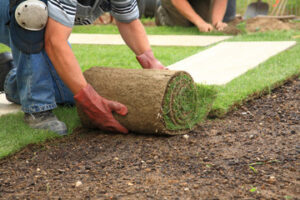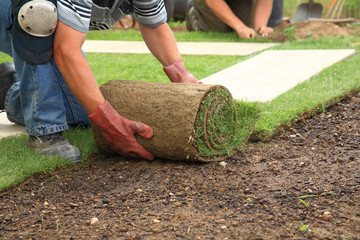Landscaping enhances the beauty of your property and increases your home’s resale value. It also provides environmental benefits and lowers energy costs.
Lines provide direction and focus for landscape elements like water features, flower gardens or trees. They can be perceived or physical and are created with the use of plants, structures or hardscape materials. Visit https://www.landscaping-greensboro.com/ to learn more.
Mulching is one of the most beneficial gardening practices you can do. It preserves moisture in the soil, suppresses weeds, and adds a finished aesthetic to garden beds and other outdoor spaces. Mulches can be organic (carbon-based) or inorganic. Organic mulches, like grass clippings and leaves, bark chips and shredded bark, straw, and buckwheat hulls are best for gardens because they improve the soil as they decompose.
Inorganic mulches, such as pebbles, stones, and even landscape fabric, provide many of the same benefits as organic materials. They are good for mulching in areas that are not used often or where you do not want to disrupt the soil structure.
When to Mulch
You can mulch at any time of year, but it is most useful around newly planted trees and shrubs, in beds with perennials that are dormant, or around herbaceous plants after a spring or autumn weeding. It also helps conserve moisture and prevents evaporation of the soil surface in summer, and insulates roots in winter.
Keep in mind, though, that too thick a layer of mulch may interfere with root growth and could even cause fungus problems. Aim for a mulch layer that is about 3 inches deep. Additionally, when you mulch, make sure it is not touching the trunks or stems of your plants as this can lead to rot.
Landscaping is the art of designing, constructing, and maintaining outdoor spaces to reflect personal taste and meet practical needs. It includes the use of both softscaping and hardscaping, with the former involving living horticultural elements such as plants, flowers, and lawns, and the latter referring to non-living, manmade components like walkways, patios, and decks.
A good landscaping project considers the size, maintenance needs, and sun/shade requirements of plants, as well as how they will look in an environment over the long term. It also addresses water management by considering both irrigation needs and drainage issues, as well as how the plants will interact with each other and their environment. This is important for creating a sustainable and harmonious landscape that will continue to thrive throughout the years.
Planting
When landscaping a home or business, it is important to consider the overall look and function of the outdoor space. Landscaping can add beauty and value to a property, create a relaxing environment, and support wildlife habitats. It is also important to take into account the amount of maintenance required for each aspect of a landscape. Landscaping can be a difficult task, but it can be accomplished with the help of professionals.
When determining what types of plants to use in your garden, it is important to choose species that will thrive in your climate and soil conditions. Professionals can recommend the best plants for your specific situation and advise you on proper planting techniques. They can also provide assistance with choosing and installing water features, such as fountains or ponds, to add interest to your garden.
There are many benefits to landscaping your property, including shaded areas for relaxation, increased privacy, and even energy savings. A well-designed and maintained landscape can also improve air quality, reduce erosion, and support wildlife habitats.
Landscapers and gardeners have similar skills, but the main difference between them is that landscapers have a greater knowledge of construction techniques and materials. Landscapers are also trained to understand how plants grow and their needs.
Landscaping includes both hardscaping and softscaping. Hardscaping refers to non-living elements of a landscape, such as walkways, patios, and retaining walls. These elements can be constructed from a variety of materials, such as stone, wood, or concrete. Softscaping includes living horticultural elements, such as flowers, shrubs, and trees, which add color and texture to a yard or garden.
To ensure that your landscape is thriving, it is important to maintain a regular maintenance schedule. This should include fertilization, watering, and pest control. It is also helpful to prune and mulch regularly to prevent weeds and promote healthy growth. By following these simple steps, you can enjoy your landscape year-round and keep it looking its best.
Watering
A healthy, attractive landscape needs good water management. Too much and plants die, too little and they wilt and can even rot, depending on the plant and region. Water conservation also saves money and reduces the amount of waste and pollution from runoff.
New plantings need frequent, deep watering to encourage roots to grow. The frequency will decrease as the roots spread and become more self-sufficient.
Summer weather requires more frequent watering. Long days, heat and humidity make it harder for the soil to hold moisture. Irregular rainfall adds to the challenge. Watering frequently helps maintain a consistent environment for the roots, which helps them adapt to seasonal conditions.
If you’re using a rain sensor in your irrigation system, set it to water early in the day when evaporation is less likely to be a problem and after the sun has gone down. Watering late in the evening can cause disease problems with wet foliage and may also increase fungal growth. Watering in the shade also helps to reduce water vapor loss from the leaf surface. Watering deeply rather than sparingly is important, especially when watering sod and other lawns. This is the best way to help the root system develop properly and quickly.
Maintenance
Effective seasonal landscape maintenance involves adapting to the different challenges and requirements of each season. For example, a garden filled with flowers and shrubs will need frequent pruning, watering, and feeding in the spring to keep them blooming. Meanwhile, the dry heat of summer might necessitate more regular watering and shading. The changing seasons also influence pests and diseases, so it’s important to be proactive in disease prevention.
The specifics of your landscape, such as soil type, the types of plants and trees you have, and your geographic location and climate, can all impact your maintenance strategies. For example, sandy soil might require a more frequent irrigation schedule than clay soil. Similarly, certain plants and trees thrive in sunny areas while others prefer shade. Understanding this information will help you create a more effective landscaping strategy that keeps your gardens healthy and beautiful.
A well-maintained commercial landscape not only reflects positively on your business, but it also provides an inviting environment for customers and visitors. Whether you need commercial landscaping services for your property landscaping experts can help. Our professional team offers nine essential commercial landscape maintenance services, including weekly or bi-weekly mowing, edging and trimming of all paved or mulched surfaces, lawn fertilization, pre-emergent and post-emergent weed prevention, irrigation system design, maintenance, and repairs, winter preparation, and monitoring and response to disease and pest infestations. Contact us to learn more about our services or to schedule a free estimate. We look forward to hearing from you!



